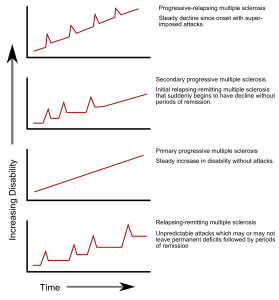Multiple Sclerosis
Brooke Hildt and Jim Hutchins
Overview
Disease Process
Types of Multiple Sclerosis

- Relapsing remitting: most common, flare ups followed by periods of remission
- Secondary progressive: begins as relapsing remitting, after a time period of relapses, disease starts to steadily progress
- Primary progressive: slowly worsening symptoms with no periods of remission, uncommon
- Progressive relapsing: rare form characterized by steadily worsening disease with occasional relapses
Signs & Symptoms
- Fatigue
- Cognitive impairment
- Muscle weakness
- Muscle spasms
- Neuropathic pain
- Vision problems (e.g., blurred vision, double vision, optic neuritis)
- Bladder control issues (e.g., urgency, frequency, incontinence)
- Dizziness
Diagnosis
Diagnosis of Multiple Sclerosis typically includes a CT or MRI scan to look for areas of scarring or demyelinating lesions, and a lumbar puncture to collect cerebrospinal fluid (CSF) for analysis of white blood cells, neurofilaments, and oligoclonal bands. A visual field and visual acuity test may also be performed to check for visual changes commonly associated with the disease.
Treatment
There is no cure for Multiple Sclerosis, but there are treatments that can reduce the number and severity of relapses and delay the long-term progression of the disease. Corticosteroids have been found to help suppress the immune system and reduce inflammation. Beta interferon drugs additionally have the ability of suppressing the immune system. Monoclonal antibodies are used to target proteins involved in autoimmune attack. Stem cell therapies are a growing area of study with a goal of regenerating nerve tissue.
Risk Factors & Disease Prevalence
Case Study
Media Attributions
- Ms_progression_types.svg © GetThePapersGetThePapers is licensed under a Public Domain license

